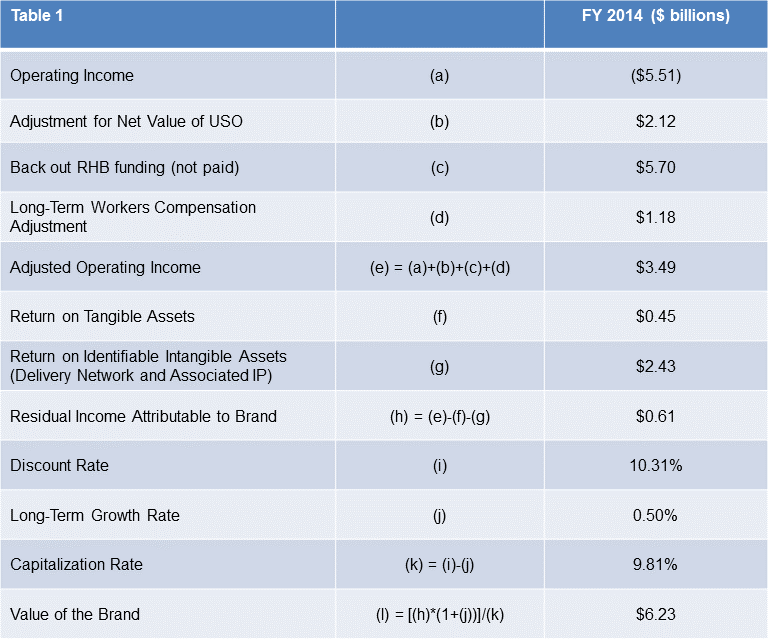Earlier this year, the United States Postal Service Office of Inspector General (USPS OIG) released a white paper documenting our computation of the corporate brand value for the United States Postal Service. In our paper, we discussed the overall methodology and calculation, drawn from our extensive work identifying and characterizing the critical brand attributes of the Postal Service’s corporate brand. One of our key brand valuation model requirements was to build a transparent and easily reproducible model that depended on publicly-available inputs (i.e., non-proprietary data). As part of our brand valuation process, we implemented the residual income approach using Fiscal Year (FY) 2013 results, as these data were the most reliable public data available at that time we finalized our valuation in October 2014. However, more contemporaneous data have become available. As a result, we can update our brand value calculation to see how the value has changed and more importantly, if the changes make sense in the context of the role and performance of the Postal Service. In this first blog post, we update our brand valuation model using FY2014 data. In our next post, we will examine whether the update makes sense and the reasons why (or why not)!
The residual income approach isolates the cash flow or income that is solely attributable to the intangible asset under study (in this case the Postal Service brand). We accomplish this by following a three-step process where we:
- Normalize the financial data to account for financial anomalies created by either regulatory or operating constraints.
- Deduct returns associated with identifiable tangible and intangible assets to isolate the brand-specific cash flow.
- Compute the brand value by capitalizing the brand-specific cash flow using an appropriate rate.
The first step in updating our brand valuation model was incorporating the FY2014 financial data. In FY2014, the Postal Service posted a loss of approximately $5.51 billion. As discussed in our original white paper, the Postal Service operates under various constraints and limitations that contribute to the significant losses it has incurred over the past three years. These constraints and limitations affect its financial condition in a generally adverse way and are the result of the circumstances that the USPS faces as a quasi-public entity that it would not face if it operated in a normal, competitive market. As a result, we normalize the income statement by making three adjustments:
- Adjustments for the cost of providing universal service (USO)
- Recognizing the value added through mailbox and letter monopolies
- Deduction of accrued expenses that the Postal Service acknowledges as costs that are legally-mandated but not under its control
In following our original methodology, we normalize the income statement for the USO by netting the mailbox/letter monopolies against the cost of the USO. We rely on estimates from the Postal Regulatory Commission (PRC) for these inputs, which are included in the PRC Annual Report to Congress. We also remove the accrued expenses that the Postal Service acknowledges as costs that are not under its control but are legally-mandated. These include the pre-funding of retirement health benefits and accounting changes to the workers’ compensation expenses.
In the second step, we compute a return on tangible contributory assets, including physical assets such as buildings, equipment and property, utilized the book value of the physical assets taken from the Postal Service balance sheet and assigned a return based on the market cost of funding these assets. In following our white paper methodology, we use a profit split approach to split the residual income between the brand intangible and the other intangible assets, allocating 80 percent of the residual income to the delivery system and network intangible and 20 percent of the residual income to the brand.
In our final step we isolate the cash flow stream that we deemed attributable to the brand and capitalize it using an appropriate capitalization rate. The capitalization rate is the discount rate less the long-term growth rate for the brand-related cash flows. The discount rate represents the required rate of return for an investment in the Postal Service corporate brand. The discount rate is a measure of the investment (brand), which includes the risk associated with receiving expected cash flows generated by the subject investment. As summarized in the following table, we compute a brand value of $6.23 billion for the Postal Service corporate brand. Although this value is within the range of values ($1.82 billion to $13.25 billion) we computed previously under different assumptions using FY2013 data, it nevertheless represents a significant increase over the $3.63 billion base value we computed in our original white paper.
So what leads to the difference in the year-to-year brand value? Is the difference reasonable? In our next blog post, we investigate the drivers of the updated brand value and test the reasonableness of the change in values.
Interested to know what your brand is worth? Have questions about how you can identify and leverage key brand attributes? Let us know how we can help.



One thought on “Updating the Value of the USPS Corporate Brand”